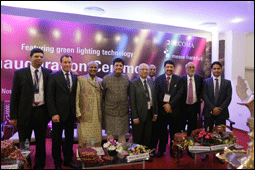The various measures being initiated by the central government as well as states to promote energy efficient lighting technologies will go a long way in making the Indian lighting industry buoyant and self reliant in the Light Emitting Diode (LED) segment.
During an interaction with Projectmonitor on the sidelines of Light India 2014, a b2b trade fair organised by the Electric Lamp and Component Manufacturers’ Association of India and Messe Frankfurt, in New Delhi, from September 18 till 21, Secretary General of ELCOMA Shyam Sujan said 27.5 million streetlights across the country were being replaced with LED lights. He added that the demand for LED lighting was being further driven by the distribution of retrofit LED lamps among BPL households under various government schemes. The distribution schemes are expected to generate a demand for 300 million retrofit LED lamps in the next two to three years.
“The industry is very happy with the boost provided to LED lighting by the government. We are going to start manufacturing in India. The Indian lighting industry is at Rs. 12,000 crore today. We expect to reach Rs. 37,000 crore by 2020,” Sujan said.

As compared to conventional lighting technologies, LED is eco-friendly and considered significantly more energy efficient. The low maintenance cost adds to its advantages. Unlike incandescent bulbs, LED does not dissipate the heat it produces, making it a cool lighting source. Also, LED has a range of applications. It can be used in signage and luminaires for indoor and street lighting as well as in cellphones. Given the flexibility, lighting companies are able to produce more designs with LED than with any other lighting technology. In case of LED outdoor lighting, the Return on Investment can be expected in two to three years. It takes between four to five years for RoI in case of indoor applications. LED has lower total ownership cost compared to competing lighting technologies and longer lifetime of 50,000 to 60,000 hours.
Reacting to the threat being posed by cheap Chinese imports at present, Sujan said that under the conditions set by the government for procurement of LED street lights and retrofit LED lamps, only those manufactured in India and meeting Indian standards would be considered.
“Indian conditions are quite different. The pioneers in LED lighting such as China, Japan, US and Europe have their own standards for LED but these are not suitable for Indian conditions. The Indian standards have been framed taking into consideration the hot, humid, dusty and polluting conditions. That is why the conditions set by the government require that the product be made in India as per Indian standards. No imported products are being allowed. We are very happy since the Indian lighting industry will be growing at a very fast pace with government support. For the moment, we have to bear with cheap imports as the Indian standards have not yet been made mandatory due to lack of adequate number of testing laboratories. However, after a period of about one year, when the standards become mandatory and the Indian lighting industry becomes self reliant in the LED segment, Indian manufacturers will take over,” Sujan said.












hi,
Thanks for sharing good post. It solved my current needs and found LED lights in India useful too.